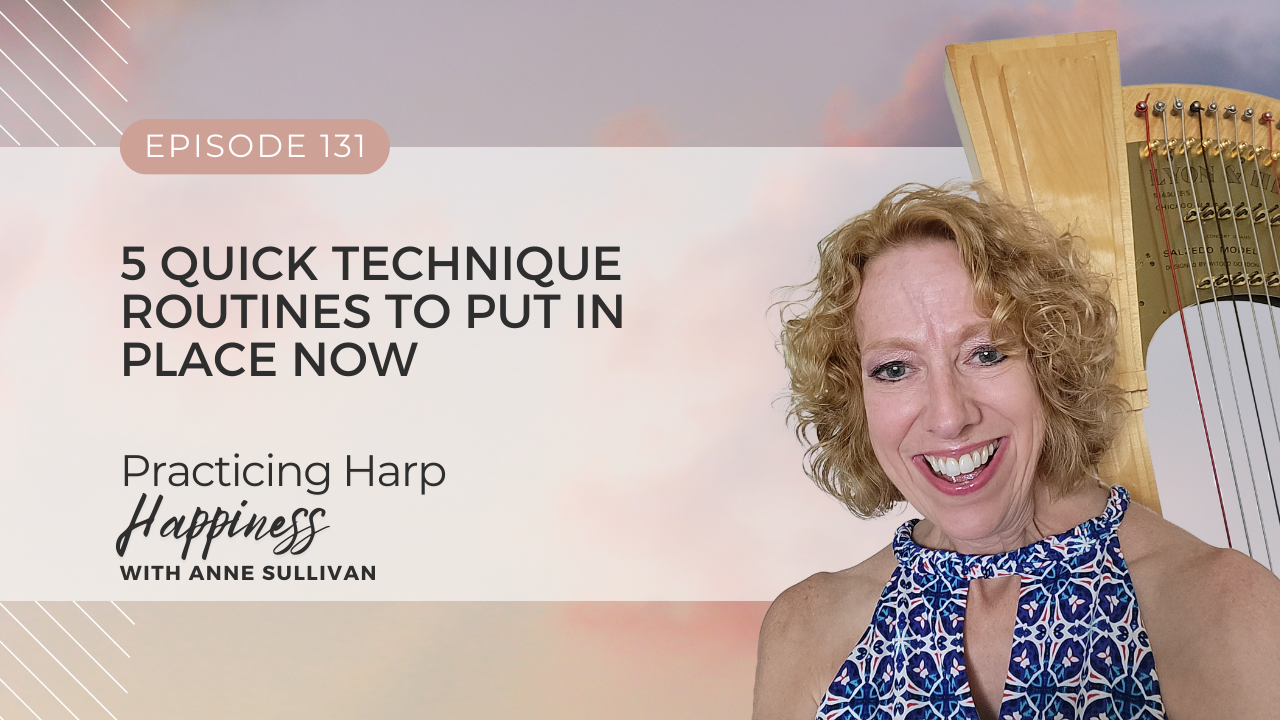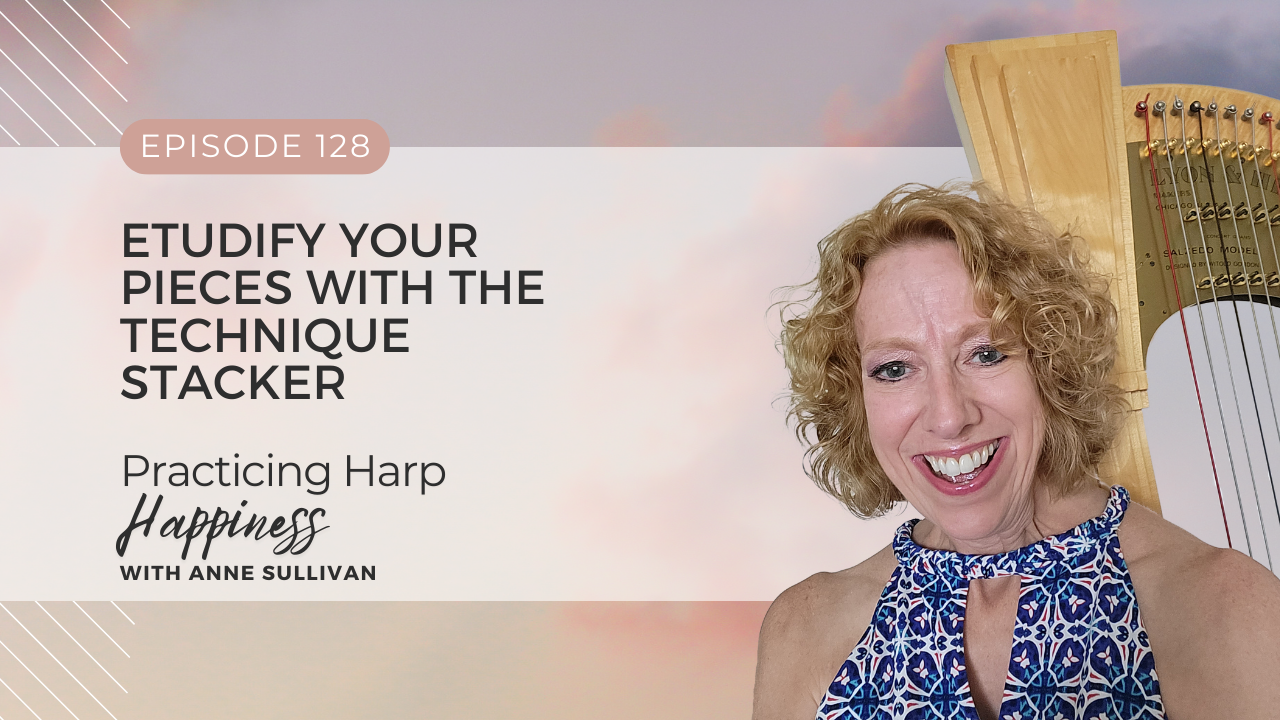Practicing Harp Happiness
#140: Agile Arpeggios: How to Make Yours Ripple

If I had to choose one finger pattern that I could count on to almost always show up in a piece, it would be an arpeggio. Arpeggios and the harp go together like peanut butter and jelly. In fact, the Italian word for harp is arpa, which has the same first three letters as arpeggio. That’s because the word arpeggio comes from the Italian word arpeggiare, which means to play on a harp. See what I mean? Peanut butter and jelly.
Whether the arpeggios show up as full sweeps of sound over the entire range of the harp or simply a left hand accompaniment pattern or anything in between, arpeggios are everywhere in harp music, so it’s essential to learn to play them well.
The first time a student comes across an arpeggio, they are shown how an arpeggio is really a chord in which all the notes are played one after the other instead of simultaneously. They are taught the rules of placing for arpeggios and given exercises to learn to read them quickly and play them fluidly. But often, when th...
#131: 5 Quick Technique Routines to Put In Place Now

Tell me if this sounds familiar. You suddenly realize that everything is quiet and you have 20 minutes all to yourself. Sure, you could sit down with a book and a cup of tea. Or you could spend that 20 minutes practicing. You decide your harp is calling you, so you sit on the bench and look at the music on your stand. But where do you start?
You may have had days like that. I know I have. Those 20 minute segments are valuable little chunks of practice time, but obviously that’s not enough time to get everything done. If you’re used to having an hour or more to practice, that 20 minutes is frustratingly short. Of course, I’m just using these time frames as an illustration. Your regular practice time and your available time might be different, but the idea is the same. When you don’t have as much practice time as you are used to, you have to find a way to make do with what you’ve got.
When we start to prioritize what needs to get done, the first thing we often jettison from our pra...
#128: Etudify Your Pieces with the Technique Stacker

If you attended my “Cut to the Chase" webinar a couple of weeks ago, you’ll remember that we were talking about some harp hacks, shortcut “outside the box” solutions for common harp problems. We’re going to talk about another one today.
Imagine that you’re learning a piece and it’s going along pretty well. In fact, you may even be excited to think how much you have improved because you’re learning so quickly. You may even let your mind wander to the sorts of pieces you can tackle next with your new and improved skills.
And then it happens. You hit the wall. You’ve found the passage you can’t play. It may be a new technique that you’ve never tried or one that you aren’t very comfortable with. It may just be a combination of two skills that you haven’t combined before. But whatever it is, you can’t do it. Your technique isn’t up to this particular challenge.
So you do what we all have to do; you take out the passage and work it separately. You turn it into an exercise and drill it...
#125: 8 Tips for Perfect Lever Or Pedal Pushing

I’m a pusher, and I hope you are one too, a lever or pedal pusher, that is.
Just imagine a world of harps without levers or pedals. Certainly, there are folk harps that don’t have levers and still play beautiful music. But to me, that’s a little like living in the forest. There is endless beauty in the forest, but I like the seashore and the prairies too. The world of music has so much harmonic richness and I really love having my pedal harp to explore it all.
Of course that harmonic richness isn’t exclusive to harps with pedals. Lever harps can play music every bit as chromatically varied as pedal harps and sometimes even more easily.
But perhaps you’re new to the world of pushers, of harp music – either lever or pedal – with accidental changes that require pushing a lever or pedal. If so, or if you’re not a newbie to pushing but would like some help with ways to improve your pedal or lever technique, then you’re in luck because that’s what we’re talking about today.
So ofte...
#122: Finger Fumbles: Is the Problem with Your Technique or Your Reading?

How can you correct a problem – any problem from a water leak to paper jam in the printer – if you don’t know where the problem really is?
Harp playing is no different. Our practice is supposed to help us fix mistakes and even prevent them from recurring, at least to a degree. But if we don’t know where the underlying issue is, it’s nearly impossible to find a fix for it.
The obvious solution to this dilemma is to ask your teacher. Unfortunately, though, even if you have access to a teacher or other harp expert, the things we want to fix usually reveal themselves in a practice session when we are working by ourselves. So we rely on our own experience to find the fix for whatever challenge we are facing, whether or not we have the experience we need to do it.
Of course, teachers don’t always have an instant solution either. Often we arrive at the solution through a process of trial and error: the student tries our suggestion and we discover we were in error. So we go on to Plan B....
#120: Make Your Warm Up a Triple

Let’s talk warm-ups.
You likely have a favorite way to warm up at the beginning of a practice session. It might be short and sweet, like an arpeggio and a scale. It might be a fairly thorough routine that allows you to check everything from your posture to your focus. Or possibly it’s just a passage from a piece that you’re learning.
Whatever you do, however you like to warm up, that’s great. I don’t want to change that today.
What I want to do is show you three different and important ways your warm-up can help you, that’s the “triple” referred to in this episode’s title. These aren’t earth-shattering or revolutionary new techniques. They are simple, clear approaches to your warm-up that will allow you to develop critical skills beyond what is usual in a warm-up. I have a warm-up that I will use to demonstrate as I teach you these approaches and it’s available for you as a free download. You’ll find the link in the show notes for this episode, which you can find either on your ...
#118: Play Tension Free: How to Calm Your Body, Mind and Music

Wouldn’t it feel great to relax?
Of course, since this is the Practicing Harp Happiness podcast, I’m not just talking about a cool drink, a good book and a bubble bath. I’m talking about being relaxed when you play the harp.
You know why it’s important to be relaxed when you play. When your hands, arms, shoulders and the rest of your body feel relaxed, you can practice and play without strain and with freedom, flexibility and flow. When your mind is relaxed, you can concentrate and focus without fear or distraction. When your mind and body are relaxed, your music can also relax so that it can communicate its mood or story in a clear, relatable way.
Does that sound too good to be true, like an impossible dream to you? Let me tell you that it isn’t impossible to achieve. More importantly, this kind of relaxation shouldn’t be just a happy accident for you.
We teachers are experts at telling our students to relax, but not so expert at showing them the tools they need to practice ...
#117: Count, Click and Canon: a Rhythm Masterclass

While there are many notable quotes from Johann Sebastian Bach, one of my favorites is this one: “There's nothing remarkable about it. All one has to do is hit the right keys at the right time and the instrument plays itself.” Okay, the man was a musical genius, but obviously he also had a remarkable talent for understatement.
On the other hand, that really is the major part of learning and playing a piece of music, at least it’s where we start. Certainly the expression of the music is our ultimate aim, but communicating the music starts with the right notes at the right time. That’s the focus of the podcast today: not so much how to find the right notes, but how to play them at the right time.
We all know it’s not as simple as Bach made it sound. In fact, the difficulties of finding that “right time” are evident everyday in our practice, even if we are expert players. See if any of these common rhythmic challenges sound familiar to you from your personal experience:
- Startin...
#113: Three Easy Ways To Get Your Hands Playing Together

There are markers along the road in every harpist’s development, signposts that indicate you’re making progress. These are like those highway signs that tell you how many miles you are from the next town or city, like “New York City - 90 miles.” No matter how long it’s taken you to get to that point and regardless of the traffic jam ahead of you on the New Jersey Turnpike, New York City is now only 90 miles away.
Graduating from three-note chords to four-note chords is one of those markers I talk about often. Another one is fluent hands together playing.
Fluent may not be the best word to describe my meaning. It’s more a comfort level, the point at which hands together playing is not any more difficult for you than playing hands separately. Many harpists develop fluency playing hands separately and then are frustrated when that fluency doesn’t translate to their hands together playing. What they don’t realize is that the processing of information that is required for hands separa...
#111: The Ultimate Time Machine: Harness The Power Of Your Metronome

Okay, here’s my question for you today. What would be the scariest words you could hear in your lesson? I can think of lots of possibilities but I’m guessing that one of those phrases that comes to your mind might be, “I think we need to get out the metronome.”
If that’s a phrase that makes you start to squirm on your harp bench, you’re not alone. Learning to use the metronome is one of those things that we teachers often fail to teach our students. Sure, we pull out the metronome in lessons and tell our students to practice with it at home, but we don’t often really show them how to work with it or when to use it and why. We almost turn it into a punishment. I sometimes worry I sound like the Wicked Witch of the West; “Well, my pretty, you counted that badly. It’s time for the metronome for you and the little dog too!”
But the metronome is for more than just identifying and solving counting errors or uneven beats. And it’s not just for pushing the tempo faster and faster. Used cr...

